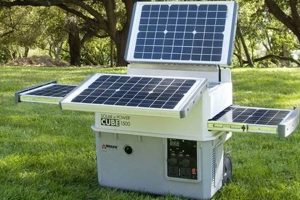Choosing between a fuel-powered generator and a battery-powered energy storage solution involves weighing several key factors. Fuel-powered options offer high power output and extended run times, fueled by readily available gasoline or propane. They are typically more affordable upfront but incur ongoing fuel costs and require regular maintenance. Battery-powered alternatives provide silent operation and emit no exhaust fumes, making them suitable for indoor or environmentally sensitive applications. While their initial cost is generally higher, operating expenses are minimal, and maintenance is simpler.
The growing demand for reliable power, whether for recreational activities, emergency preparedness, or off-grid living, has driven significant advancements in both technologies. Historically, combustion engines provided the only portable power option. However, recent battery technology improvements have led to the emergence of powerful, portable power stations capable of rivaling traditional generators in certain applications. This evolution provides consumers with a wider range of choices tailored to specific needs and priorities.
The following sections will delve deeper into the specific advantages and disadvantages of each option, considering factors like power output, runtime, portability, noise levels, fuel efficiency, environmental impact, and overall cost of ownership. This comprehensive analysis will empower consumers to make informed decisions aligned with their individual power requirements and usage scenarios.
Choosing the Right Power Source
Selecting between a fuel-based generator and a battery-powered station requires careful evaluation of individual power needs and usage scenarios. The following tips offer guidance for navigating this decision-making process.
Tip 1: Assess Power Requirements: Determine the wattage required to run essential devices. Consider peak power demands and the combined wattage of all devices intended for simultaneous use.
Tip 2: Evaluate Runtime Needs: How long is a continuous power supply required? Fuel-powered generators offer extended run times, while battery-powered options are limited by their capacity. Consider recharging capabilities.
Tip 3: Consider Noise Tolerance: Conventional generators produce noise, a critical factor for campsites or noise-sensitive environments. Battery-powered alternatives operate silently.
Tip 4: Factor in Portability: Assess the weight and size of each option, especially if portability is crucial. Battery-powered stations are generally lighter and more compact.
Tip 5: Analyze Fuel and Operating Costs: Fuel-based generators require ongoing fuel purchases and periodic maintenance. Battery-powered options have minimal operating costs but a higher initial investment.
Tip 6: Think About Environmental Impact: Traditional generators produce exhaust fumes. Battery-powered solutions offer a cleaner, emissions-free alternative.
Tip 7: Evaluate Maintenance Requirements: Fuel-powered generators require regular maintenance, including oil changes and spark plug replacements. Battery-powered units require minimal maintenance.
Careful consideration of these factors will enable informed decision-making, resulting in a power solution aligned with specific needs and priorities. The optimal choice depends on the intended application and the balance between power output, runtime, portability, noise level, environmental impact, and overall cost.
By weighing these aspects, individuals can select the most suitable power source to meet their individual requirements, ensuring reliable access to electricity wherever needed.
1. Power Output
Power output represents a critical differentiator between gas generators and portable power stations, directly influencing the types of devices and appliances they can effectively operate. Understanding the nuances of power output is crucial for selecting the appropriate power solution for specific needs.
- Rated Power (Watts):
Rated power signifies the continuous power output a generator or power station can sustain over an extended period. Gas generators generally offer higher rated power, ranging from several thousand watts to over ten thousand, enabling them to power larger appliances like refrigerators or air conditioners. Portable power stations typically offer lower rated power, making them suitable for smaller electronics and devices. Matching the rated power to the combined wattage of intended devices is essential for safe and reliable operation.
- Surge Power (Watts):
Surge power, also known as starting watts or peak power, refers to the temporary burst of power available for a short duration. Certain appliances, like power tools or refrigerators, require a surge of power upon startup. Gas generators often provide higher surge power than their rated power, accommodating these initial power demands. Portable power stations also offer surge capacity, though typically lower than gas generators. Ignoring surge requirements can lead to tripped breakers or insufficient power for startup.
- Running Watts vs. Starting Watts:
Understanding the distinction between running watts (rated power) and starting watts (surge power) is fundamental. Running watts define the continuous power supply, while starting watts handle temporary surges. Choosing a power source with sufficient starting watts prevents issues with appliances requiring higher initial power. This distinction is particularly crucial for motor-driven appliances and tools. Gas generators often have a larger gap between running and starting watts, while portable power stations have a smaller difference.
- Power Output and Appliance Compatibility:
Aligning the power output of a generator or power station with the specific power requirements of intended appliances is essential. Attempting to power devices exceeding the generator’s or power station’s capacity can lead to overloads and potential damage. Consulting appliance specifications for wattage requirements ensures compatibility and safe operation. This correlation between power output and appliance compatibility is fundamental to successful power solution selection.
Considering these facets of power output helps determine the suitability of a gas generator versus a portable power station for specific applications. Evaluating power needs, considering both running and starting watts, and understanding appliance compatibility empowers informed decision-making for reliable power solutions.
2. Runtime
Runtime represents a critical factor differentiating gas generators and portable power stations. It signifies the duration a power source can operate continuously before requiring refueling or recharging. This duration significantly impacts usability and suitability for various applications. Gas generators typically offer extended runtimes due to the readily available nature of gasoline or propane. A large fuel tank can provide continuous power for several hours or even days, depending on the load and generator’s efficiency. This extended runtime makes gas generators suitable for scenarios requiring prolonged power access, such as extended outages or remote work sites. Portable power stations, however, have runtimes limited by their battery capacity. While advancements in battery technology continue to improve capacity, power stations generally offer shorter runtimes compared to gas generators. Their runtime depends on the battery’s size and the power draw of connected devices. For instance, powering a small lamp will result in a longer runtime than powering a refrigerator. Understanding these runtime limitations is crucial for effective power planning.
Consider a scenario involving a multi-day camping trip. A gas generator, with its extended runtime fueled by readily available gasoline, can power essential camping equipment like lights, cooking appliances, and even small refrigerators for the duration of the trip. Conversely, a portable power station, while convenient for charging smaller devices like phones and laptops, might require frequent recharging depending on usage, making it less suitable as the sole power source for extended off-grid excursions. In a different scenario, such as a short-term power outage at home, a portable power station can provide sufficient power for essential electronics and appliances for a limited time, bridging the gap until grid power is restored. However, for extended outages, a gas generator’s longer runtime provides a more reliable solution for sustained power needs. The choice between a gas generator and a portable power station depends on the specific application and the required duration of continuous power.
The practical significance of understanding runtime lies in effective power planning and ensuring that the chosen power source aligns with the specific demands of a given situation. Evaluating the anticipated power needs and the expected duration of use are crucial steps in selecting the appropriate power solution. Balancing runtime requirements with other factors like portability, noise levels, and environmental impact allows for informed decision-making, ensuring reliable access to power when and where it is needed.
3. Portability
Portability represents a key differentiator between gas generators and portable power stations. The weight and size of these power sources significantly influence their ease of transport and suitability for various applications. Gas generators, often designed for higher power output, tend to be larger and heavier than portable power stations. Their robust construction and larger fuel tanks contribute to increased weight, making them less maneuverable and requiring more effort to transport. This can be a limiting factor for activities like camping or tailgating, where ease of movement and compact storage are essential. Portable power stations, conversely, prioritize compact design and lighter weight. Advancements in battery technology allow for smaller and lighter batteries capable of storing significant power. This focus on portability makes power stations ideal for on-the-go power needs, enabling easy transport and convenient storage in various settings.
Consider a scenario involving a weekend camping trip. Transporting a heavy gas generator over uneven terrain to a remote campsite presents a logistical challenge. A lighter, more compact portable power station, on the other hand, can be easily carried and stored, providing convenient access to power without the burden of excessive weight. In another scenario, such as a mobile workstation or an outdoor event, the portability of a power station allows for flexible placement and easy relocation as needed. The weight and size of a gas generator might limit its practicality in these scenarios. Choosing between a gas generator and a portable power station often involves a trade-off between power output and portability. Gas generators offer higher power output but compromise on portability, while portable power stations prioritize ease of transport and compact design, potentially offering less power output. Understanding these trade-offs empowers informed decisions based on the specific power requirements and portability needs of a given situation.
The practical significance of portability lies in its impact on usability and convenience. The ease of transport and storage offered by portable power stations expands their applicability across diverse settings, from outdoor adventures to emergency preparedness. While gas generators excel in providing higher power output, their portability limitations restrict their suitability for applications requiring mobility and ease of movement. The optimal choice depends on a careful assessment of power needs balanced against portability requirements, ensuring a power solution that aligns with the specific demands of a given situation.
4. Noise Levels
Noise levels represent a significant distinguishing factor between gas generators and portable power stations, impacting their suitability for various environments and applications. The noise generated by these power sources influences user comfort and environmental considerations, making it a crucial factor in the selection process.
- Decibel Levels and Human Perception
Gas generators typically produce noise levels ranging from 60 to 70 decibels or higher, comparable to the sound of a vacuum cleaner or a busy street. This level of noise can be disruptive and uncomfortable, especially in quiet environments like campsites or residential areas. Portable power stations, conversely, operate much more quietly, often producing noise levels below 50 decibels, similar to a quiet conversation. This significant difference in decibel levels highlights the impact on user experience and environmental considerations.
- Environmental Impact of Noise Pollution
The noise generated by gas generators contributes to noise pollution, potentially disturbing wildlife and impacting the tranquility of natural environments. In noise-sensitive areas, such as national parks or protected areas, the use of gas generators might be restricted or prohibited due to their noise impact. Portable power stations, with their quiet operation, minimize noise pollution, offering a more environmentally friendly alternative in these sensitive locations.
- Impact on User Comfort and Convenience
The noise produced by a gas generator can significantly impact user comfort, especially during extended use. Prolonged exposure to high noise levels can be fatiguing and disruptive, making it less desirable for applications like camping or outdoor events. The quiet operation of portable power stations enhances user comfort, allowing for conversation and enjoyment of the surrounding environment without intrusive noise.
- Regulations and Restrictions on Noise Emissions
Certain locations, like residential areas or campsites, may have regulations or restrictions on noise emissions, limiting the permissible noise levels of power sources. Gas generators, with their higher noise output, might not comply with these regulations, restricting their usage in such environments. Portable power stations, adhering to lower noise limits, offer a compliant solution in noise-regulated areas.
The contrast in noise levels between gas generators and portable power stations directly influences their suitability for different applications. The quiet operation of portable power stations makes them ideal for noise-sensitive environments and enhances user comfort, while the higher noise levels of gas generators can be a limiting factor in certain situations. Careful consideration of noise levels ensures the selection of a power solution that aligns with environmental considerations and user comfort preferences.
5. Fuel/Energy Source
The fuel or energy source employed by a power solution significantly influences its operational characteristics, environmental impact, and overall cost. This distinction represents a core difference between gas generators and portable power stations, shaping their suitability for various applications.
- Fossil Fuels (Gas Generators)
Gas generators primarily utilize fossil fuels, such as gasoline or propane, for power generation. These fuels are readily available and offer high energy density, enabling extended runtimes. However, the combustion of fossil fuels produces exhaust fumes, contributing to air pollution and greenhouse gas emissions. The reliance on finite fossil fuel resources also raises environmental sustainability concerns. Furthermore, the fluctuating cost of fossil fuels introduces an element of price volatility into the operating expenses of gas generators.
- Rechargeable Batteries (Portable Power Stations)
Portable power stations employ rechargeable batteries, typically lithium-ion, as their energy source. These batteries offer a clean, emissions-free alternative to fossil fuels, eliminating exhaust fumes and minimizing environmental impact. While the initial cost of battery-powered solutions might be higher, the absence of fuel costs and reduced maintenance requirements can offset this investment over time. Furthermore, advancements in battery technology continue to improve energy density and lifespan, enhancing the performance and longevity of portable power stations. The dependence on external charging sources, however, presents a limitation in certain off-grid scenarios.
- Environmental Impact and Sustainability
The choice between fossil fuels and rechargeable batteries directly impacts environmental sustainability. Gas generators, while offering convenient access to power, contribute to air pollution and greenhouse gas emissions. Portable power stations, with their clean energy storage, align with environmentally conscious practices and minimize the carbon footprint associated with power generation. This environmental consideration plays a crucial role in responsible power solution selection, particularly in ecologically sensitive areas.
- Cost Considerations: Fuel vs. Electricity
The long-term cost of ownership differs significantly between gas generators and portable power stations. Gas generators incur ongoing fuel expenses and require periodic maintenance, including oil changes and spark plug replacements. Portable power stations, while having a higher upfront cost, eliminate fuel expenses and minimize maintenance requirements. The long-term cost-effectiveness depends on usage patterns and the fluctuating price of fossil fuels. Calculating the total cost of ownership over the expected lifespan of each power source facilitates informed financial decision-making.
The fuel/energy source distinction underscores the fundamental difference between gas generators and portable power stations, impacting their environmental footprint, operational costs, and suitability for various applications. Careful evaluation of these factors empowers informed decision-making, enabling selection of a power solution aligned with individual needs and environmental priorities.
Frequently Asked Questions
This section addresses common inquiries regarding the selection and utilization of gas generators and portable power stations.
Question 1: Which option is more suitable for emergency home backup power during extended outages?
Gas generators typically offer a more reliable solution for extended outages due to their longer runtimes fueled by readily available gasoline or propane. However, considerations for fuel storage and safe operation are essential.
Question 2: What are the primary environmental considerations when choosing between these power sources?
Gas generators produce exhaust fumes, contributing to air pollution. Portable power stations offer a cleaner alternative, utilizing rechargeable batteries and producing no emissions during operation.
Question 3: Which option is better suited for powering smaller electronics like laptops and smartphones while camping?
Portable power stations are generally more suitable for charging smaller electronics due to their portability, quiet operation, and ease of use. Their compact size and lighter weight make them ideal for camping trips.
Question 4: What maintenance is typically required for gas generators and portable power stations?
Gas generators require regular maintenance, including oil changes, spark plug replacements, and air filter cleaning. Portable power stations require minimal maintenance, primarily involving proper battery care and storage.
Question 5: How does the cost of ownership compare between these two power solutions over the long term?
Gas generators involve ongoing fuel costs and periodic maintenance expenses. Portable power stations have a higher initial investment but eliminate fuel costs and require less maintenance, potentially offering long-term cost savings.
Question 6: Which option is recommended for noise-sensitive environments, such as campsites or residential areas?
Portable power stations are the preferred choice for noise-sensitive environments due to their quiet operation. Gas generators produce significant noise, which can be disruptive and undesirable in such settings.
Careful consideration of these factors allows for informed decision-making, ensuring the chosen power solution aligns with individual needs and priorities.
The subsequent section delves deeper into specific use cases and applications for gas generators and portable power stations.
Conclusion
Careful evaluation of power needs, runtime requirements, portability considerations, noise tolerance, environmental impact, and long-term costs clarifies the distinctions between gas generators and portable power stations. Each technology presents unique advantages and disadvantages, catering to specific applications and user priorities. Gas generators excel in providing high power output and extended runtimes, making them suitable for demanding applications and prolonged power needs. Portable power stations prioritize clean operation, quiet performance, and convenient portability, offering an attractive alternative for noise-sensitive environments and on-the-go power requirements.
The optimal selection depends on a thorough assessment of individual circumstances and power demands. As technology continues to advance, further improvements in battery capacity, fuel efficiency, and noise reduction are anticipated, expanding the capabilities and applications of both gas generators and portable power stations. Informed decision-making, driven by a comprehensive understanding of these power solutions, empowers consumers to select the most appropriate technology for their specific needs, ensuring reliable access to power wherever and whenever required.






